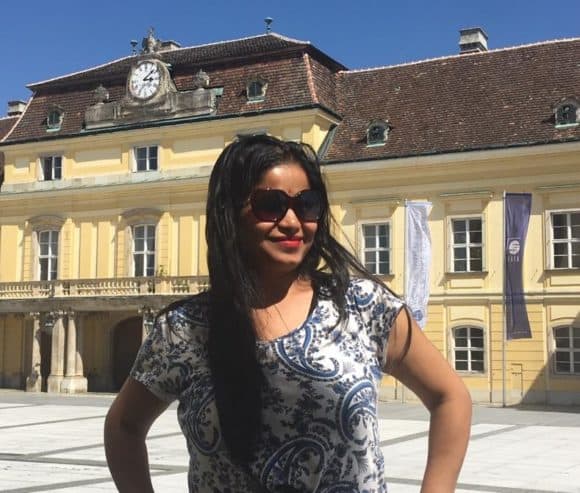By Nandita Saikia, Assistant Professor of Population Studies at Jawaharlal Nehru University, New Delhi, and former postdoctoral researcher at IIASA
IIASA alumna Nandita Saikia, looks back on the two years that she spent living in Austria while working as a postdoctoral researcher in the World Population Program.
The submission of my PhD thesis, marriage, taking up a university position, and becoming a mother, all happened rather quickly for me. By the time I realized that I wanted to experience working outside of my own country, a good five years had flown by from the day that I received my PhD. For a female academic, who is trying to balance family and work, a decision to move abroad was never going to be easy. It needed a lot of planning, not only in terms of the research topic that I wanted to pursue, but also in terms of organizing things in a way that would lead to the least disruption for the research students I was supervising and of course, my family.

Nandiita Saikia | © Nandita Saikia
With little hope and many conditions, I searched for postdoctoral positions on the websites of various institutes. I was amazed when I found an advertisement for a postdoc position at IIASA, which mentioned that it had extended application deadlines for another 18 months – specifically to accommodate female candidates on maternity leave. This gender sensitive rule made my application possible, and ultimately gave me a rich experience and memories that I will cherish forever.
Looking back at the past two years at IIASA, a long list of reasons why this was such an amazing time of my and my family’s lives, comes to mind. The institute is housed in a beautiful two hundred and seventy five year old castle in Laxenburg just outside of Vienna. As an IIASA employee, my family and I could access the green imperial park once meant for Austria’s iconic empress Sissi, at any time. Apart from massive, century old trees that may have shaded Sissi on her own visits, the park contains a spring, a waterfall, and a lake with numerous monuments to Austrian royal families that frequented it over the centuries. The lush green trees, the musical sound of the spring, together with chirping wild ducks and swans, the Laxenburg castles, the tall yellow church under the deep blue sky – all constantly stimulated the spirit of a nature lover like me.
In terms of the more practical aspects of working at IIASA, staff from administration were always available to address all our personal and professional issues efficiently and warmly. We were supported with everything from extending our visas, finding a suitable place to live, and communicating with my son’s school in German, to locating the right physician. The IIASA Communication Department also helped me to convey the meaning of my research in “non-technical language” to a wider audience, for whom the findings are ultimately meant.
The soul of IIASA is truly international and inter-disciplinary. From North to South, East to West, I met colleagues from all parts of the world. The overall research environment is conducive to doing quality research. Our program director, Wolfgang Lutz, extended all possible support for me to stay at IIASA for two years. I however still had enough freedom to manage my responsibilities in terms of the supervision of my PhD students back in India.
IIASA always encourages its employees to be active and fit and supports them to do this in numerous ways. There are a number of clubs and activities on offer, including yoga, a music club, a running club, a swimming club, cycling, German lessons, aerobics, and a tennis club. The institute also maintains a gym for staff members. Some of my colleagues even kept workout clothes in the office for when they could manage to participate in some of these activities amidst their busy schedules. Although it was of course not possible to be in all the clubs, you had a choice, which contributed to the overall “feel good” environment. Being an international research organization, IIASA celebrates the different cultures of its staff members by organizing themed social gatherings like Asia Day, Latin American Day, Canada Day, and Mediterranean Day, to name a few, during which staff have the chance to taste authentic homemade cuisines and see cultural music or dance performances by colleagues. My heart knew no bounds when I got a chance to perform a Bollywood number and an Indian folk dance with my international colleagues!
I also developed an affinity with the IIASA Women in Science Club, which often organized “Meet, Greet and Eat” sessions during which we had the opportunity to interact with established women scientists in an informal way. It was indeed an eye opener to learn about how they overcame common challenges either in their early or later careers.
During our stay, we fully experienced life in Vienna, which has repeatedly been ranked as the best city in the world to live in. The centrality of Vienna also helped us to explore many neighboring countries. In our second year, we lived in Laxenburg where we felt very much at home. We loved how smoothly the little town runs while offering everything needed for a high quality life when raising young children.
Our time at IIASA was extremely productive, but we still felt as if we were in Vienna for a two-year long vacation! If someone asks me whether they should consider IIASA for a post doc or the Young Scientists Summer Program, my answer will be: “Yes, don’t even think twice!”
Nandita Saikia was a postdoctoral researcher at IIASA from 2017 to 2019. More information available at www.nanditasaikia.com.
Note: This article gives the views of the author, and not the position of the Nexus blog, nor of the International Institute for Applied Systems Analysis.

You must be logged in to post a comment.